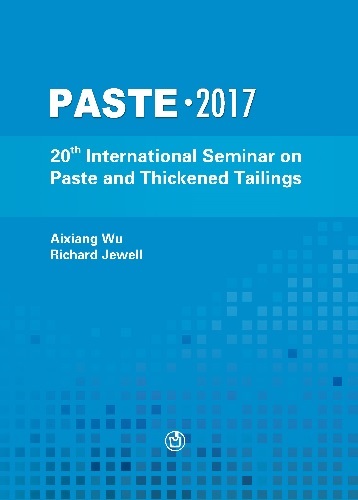Translating paste backfill admixture results from the laboratory into the field

|
Authors: Erismann, F; Kurz, C; Hansson, M; Almas, J |
DOI https://doi.org/10.36487/ACG_rep/1752_22_Erismann
Cite As:
Erismann, F, Kurz, C, Hansson, M & Almas, J 2017, 'Translating paste backfill admixture results from the laboratory into the field', in A Wu & R Jewell (eds), Paste 2017: Proceedings of the 20th International Seminar on Paste and Thickened Tailings, University of Science and Technology Beijing, Beijing, pp. 190-198, https://doi.org/10.36487/ACG_rep/1752_22_Erismann
Abstract:
Paste backfill admixtures have been used in mine paste backfill plants for many years. Their use has been targeted to improve specific properties of the paste such as the water and binder requirements for a certain workability and strength, to improve the slump and flow characteristics, to reduce paste line pressures or to enhance the stability of the paste in order to reduce risk of line blockages. The economic justification for the use of paste backfill admixtures was in earlier days questioned in projects across the world as visible operational cost improvements could not always be clearly demonstrated. With the development of new generation paste backfill admixtures over the past years, the economic benefits can now be clearly demonstrated. State of the art admixtures can impact the economics of paste plants and associated infrastructures significantly. Sika together with its partners utilised lessons learned from concrete admixtures and translated this knowledge in order to apply the same p rinciples in paste plants across the globe. Significant cement reduction targets of up to 50% could be reached, which changed the perception towards the use of admixtures significantly. Translating initial laboratory results into the field remains one of the key challenges. This paper will outline this critical transition from laboratory into the field using three case studies from mines located in Europe and Africa. The results obtained in the laboratory can often be translated into the real world with minor variances of the critical parameters such as the admixture dosage, slump and strength development but we also show that there are exceptions. Understanding the actual origin and composition of the paste remains critical for the selection of the best performing paste backfill admixture and for a successful transition from promising laboratory results into the field.
References:
Arribas, A., Hedenquist, J.W., Itaya, T., Okada, T. Concecion, R.A. and Garcia, J.S. 1995, ‘Contemporaneous formation of adjacent porphyry and epithermal Cu-Au deposits over 300 ka in northern Luzon, Philippines’. Geology, vol. 23, pp. 337-40.
Dubé, B., Williamson, K., Mcnicoll, V. 2004, ‘Timing of Gold Mineralization at red Lake, Northwestern Ontario, Canada: New Constraints from U-Pb Geochronology at the Goldcorp High-Grade Zone, Red Lake Mine and the Madsen Mine’, Economic Geology.
Erismann, F., Hansson M., Kurz, Ch., O’Hara, S. 2016, ‘The Benefits of Incorporating Admixtures into Mine Paste Backfill’, Proceedings of the 19th International Seminar on Paste and Thickened Tailings, Gecamin, Santiago.
Moore, D.W., Young, L.E., Modene, J.S., Plahuta, J.T. 1986, ‘Geologic setting and genesis of the Red Dog zinc-lead-silver deposit, Western Brooks range, Alaska’. Economic Geology, pp, 1696-727.
Ojala, J., Ridley J.R., Groves D.I., Hall G.C. 2003, ‘The Granny Smith gold deposit: the role of heterogeneous stress distribution at an irregular granitoid contact in a greenschist facies terrane’, Mineralium Deposita vol.28 no. 6, pp. 409-419.
Robb, L.J. 2005, Introduction to ore forming processes.
Yao, J., Robb L.J. 2000, ‘Gold mineralization in Palaeoproterozoic granitoids at Obuasi, Ashanti region, Ghana:Ore geology, geochemistry and fluid characteristics’. South African Journal of geology, vol. 103, pp. 255-278.
© Copyright 2025, Australian Centre for Geomechanics (ACG), The University of Western Australia. All rights reserved.
View copyright/legal information
Please direct any queries or error reports to repository-acg@uwa.edu.au
View copyright/legal information
Please direct any queries or error reports to repository-acg@uwa.edu.au